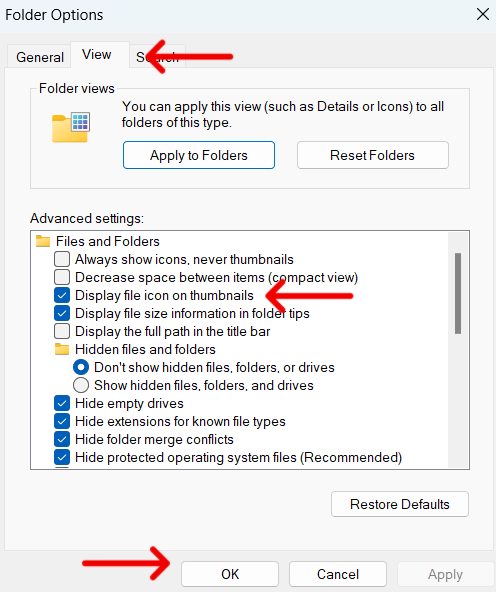In Windows 11, File Explorer overlays file type icons on thumbnails (such as PDF, DOCX) to help users quickly identify the default application. While it’s useful for helping users distinguish between file types, it can become visually distracting or redundant, especially in environments that must prioritize clean visuals or custom icon overlays.
In this guide, we discuss the various ways of enabling or disabling the “Display file icon on thumbnails” option.
📌 Recommended deployment strategies:
Click to Choose a Method | 💻 Best for Individual Users | 💻💻💻 Best for Enterprises |
| Method 1: Using File Explorer | ✓ | |
| Method 2: Using Registry Editor | ✓ | |
| Method 3: Using PowerShell | ✓ | ✓ |
| Method 4: .reg file example | ✓ | ✓ |
Modifying “Display file icon on thumbnails”
Method 1: Using File Explorer
📌 Use case: Best suited for individual user environments where users need quick, one-time visual adjustments
📌 Prerequisites:
- No administrative privileges required
- Users must have access to File Explorer settings.
- Applies only to the currently logged-in user
- Takes effect immediately after clicking OK.
Steps:
- Open File Explorer (Win + E).
- Click the ⋯ (three-dot menu) in the toolbar and choose Options.
- In the Folder Options dialog box, select the View tab.
- Find the checkbox Display file icon on thumbnails.
- Checked: Enables overlay icon (default).
- Unchecked: Disables overlay icon.
- Click Apply, then OK.

Method 2: Using Registry Editor
📌 Use Case: Recommended for power users or administrators who want granular control over user experience
📌 Prerequisites:
- You need administrator rights if you are editing for other users.
- Registry Editor access must be enabled.
- A backup of Registry is highly recommended.
- Requires a restart of File Explorer or the user session to take effect
Steps:
- Press Win + R, type regedit, and click Enter.
- Go to: HKEY_CURRENT_USER\Software\Microsoft\Windows\CurrentVersion\Explorer\Advanced
- Locate or create a DWORD (32-bit) Value named ShowTypeOverlay.
- Set its value:
- 1: Enable file type icon overlay (default)
- 0: Disable file type icon overlay
- Close Registry Editor.
- Restart File Explorer.
Method 3: Using PowerShell
📌 Use Case: Best for one-click deployment, offline environments, or inclusion in post-installation scripts. Practical for MSPs needing a low-overhead solution without scripting.
📌 Prerequisites:
- Must have administrator privileges.
- Requires PowerShell access.
- File Explorer must be restarted for changes to take effect.
- It’s highly recommended that you sign up for the free crash course, PowerShell for IT Ninjas.
Steps:
- Open PowerShell.
- Execute the following commands, as needed:
Disable icon overlay:
Set-ItemProperty -PathHKCU:\Software\Microsoft\Windows\CurrentVersion\Explorer\Advanced-Name ShowTypeOverlay -Value 0 Stop-Process -Name explorer -Force
💡 This command restarts Explorer
Enable icon overlay:
Set-ItemProperty -Path HKCU:\Software\Microsoft\Windows\CurrentVersion\Explorer\Advanced-Name ShowTypeOverlay -Value 1 Stop-Process -Name explorer -Force
💡 Note: This command restarts Explorer.
Method 4: .reg file example
📌 Use Case: Best for one-click deployment, offline environments, or inclusion in post-installation scripts.
📌 Prerequisites:
- You must have permission to merge .reg files.
- You must have administrator rights, especially if you’re targeting other user profiles.
- File Explorer must be restarted for the changes to take effect.
Disable file icons on thumbnails:
Windows Registry Editor Version 5.00
[HKEY_CURRENT_USER\Software\Microsoft\Windows\CurrentVersion\Explorer\Advanced]
“ShowTypeOverlay”=dword:00000000
Enable file icons on thumbnails:
Windows Registry Editor Version 5.00
[HKEY_CURRENT_USER\Software\Microsoft\Windows\CurrentVersion\Explorer\Advanced]
“ShowTypeOverlay”=dword:00000001
📌 To deploy: Save as a .reg file and run to apply changes. Make sure to restart File Explorer afterward.
⚠️ Things to look out for
| Risks | Potential Consequences | Reversals |
| Incorrect registry value | The icon overlay may not behave as expected. | Double-check the DWORD name and value (ShowTypeOverlay) and reset to the known good configuration. |
| Modifying the wrong user hive | Changes may not apply at all, or may affect unintended profiles in multi-user systems. | Always confirm the correct SID or use HKEY_CURRENT_USER for the active user. |
| No immediate visual change | Setting may appear ineffective due to cached Explorer states | Restart File Explorer or sign out and sign back in to enforce the new setting. |
| Lack of administrative rights | Scripts, .reg files, or Registry edits may fail silently or trigger UAC prompts. | Run elevated, or deploy through RMM/Group Policy Preferences where applicable. |
Additional considerations when modifying “Display file icon on thumbnails”
- Per-user cope: All changes listed in this guide apply only to the currently logged-in user.
- No ADMX/GPO: Currently, there is no native Group Policy with an ADMX template for ShowTypeOverlay. IT admins must use registry preferences or scripts.
- Thumbnail cache unaffected: You don’t need to clear the thumbnail cache when changing this setting. The overlay appearance is independent of cached images.
- Applicable file types: Effective for images, videos, PDFs, Office documents, and other supporting thumbnail previews.
Disable “Display file icon on thumbnails” for a cleaner interface
Disabling the display file icon on thumbnails allows IT admins and power users to deliver cleaner, more focused File Explorer experiences, especially in media-heavy, design-driven, or managed environments.
Related topics:







